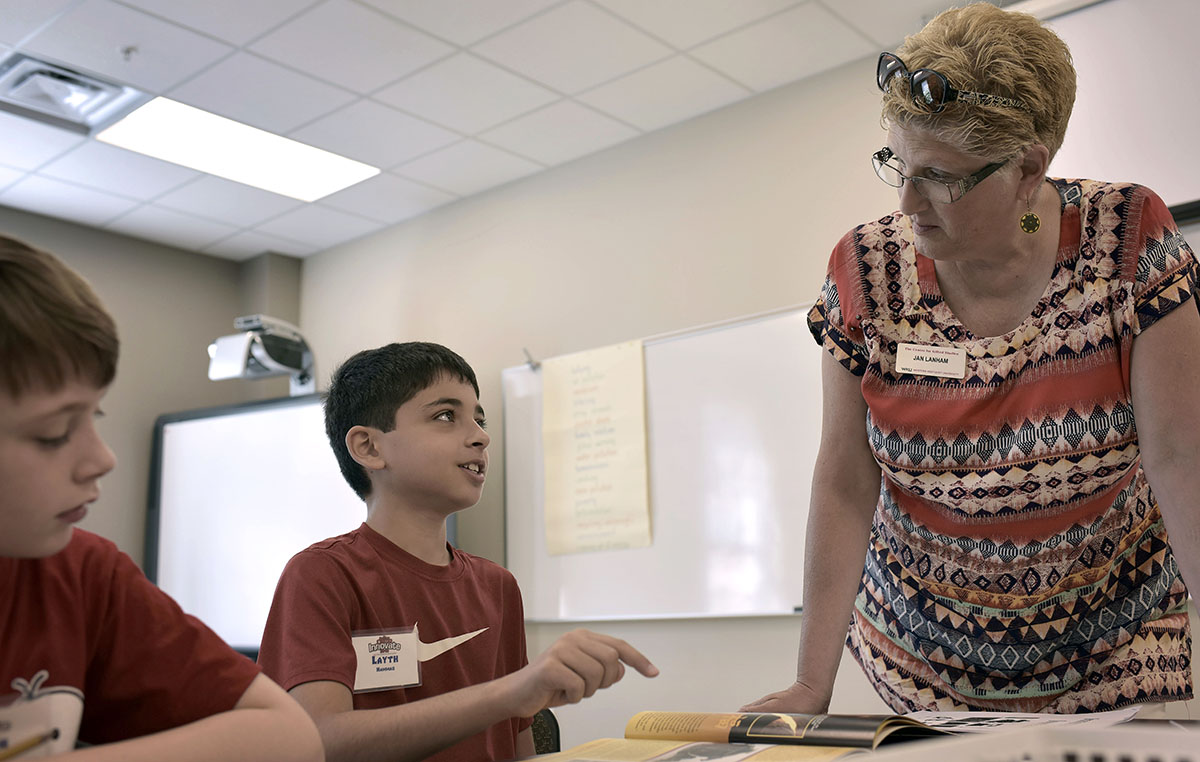By Josh Raymer
Ask most people to name examples of innovations and they will probably mention cutting-edge examples of technology and engineering: driverless cars, drones, virtual reality goggles, or the latest smartphone. Students in Camp Innovate, offered for the second year by The Center for Gifted Studies, are learning that innovation can be found in every subject area if students are willing to embrace new ways of learning.
“Gifted kids are smart, and if they’re smart, they’re always right,” explained Jennifer Sheffield, the Science teacher at Camp Innovate. “There’s this fear of being wrong, so gifted kids don’t innovate because if it’s wrong, they think they’re not smart. We have to take that fear away. They’re just experimenting and trying things, and that can look like play. We have to get students past right and wrong.”
What does experimenting as play look like in science? Jennifer’s class challenged campers from day one with a building activity that included popsicle sticks, paper cups, and wooden cubes. The towers campers constructed, Jennifer revealed, ultimately fell before the activity was over. The lesson was meant to teach them about cantilevers and reinforce an important lesson in innovation: fail often, fail early, and fail fast.

Failure is an opportunity for problem solving in Andee Rudloff’s Art class as well. Instead of scrapping their artwork and starting over, campers are expected to turn their mistakes into something beautiful. With an old-school approach to art, Andee expects her students to make plenty of “mistakes” as they utilize various tools of the trade.
“To go back to tangible, old-school methods of art making is such a huge shift for a lot of these students,” Andee noted. “To actually have to blend paint instead of using a phone app like Blendoku and deal with the messiness of it all is fun. It’s fun with art to see not only problem solving but risk taking from these students. To have them try something and, if it doesn’t work out, figure out how they can make it work.”
Another important component of Camp Innovate is the idea that learning isn’t separated into specific subject areas in the real world. Innovation bleeds from one area to another and those who can take art and mix it with language arts, or those who can utilize science and math skills are the ones who will truly break new ground.
Art is bleeding over into Language Arts this week through the creation of a visual language. By working on gestures and then collaborating with others using a storytelling model, Art students will end the week with their own visual language similar to the ones we see every day: emojis, icons, logos, and universal hand signals.
In Jan Lanham’s Language Arts class, campers are using reading and writing as tools to explore real-world problems. Activities include reading about innovation from other cultures and then studying young people who’ve made a difference in the world. From there, campers select a real-world problem they want to tackle and design a plan for solving it through efforts like brochures, letter writing, or a social media campaign.
Too often, Jan elaborated, gifted students grapple with difficult issues without feeling like they can make a difference. “For gifted young people, oftentimes they’re aware of adult issues but feel powerless,” she said. “It weighs on them. As a kid, they wonder how they can make a difference. That’s why we’re looking at role models.”
“This project is an attempt to empower students by using the innovation and problem solving piece from an activist standpoint,” Jan described. “We’re integrating reading to build the knowledge base about the issue. They’re doing self-reflection about what innovative qualities they have and setting a goal to develop a new quality.”

“Part of innovation is taking those walls down between subject matters,” Jennifer shared. “When you take a little of this and a little of that is when you get something new.”
Students are enjoying a new approach to Math in the class taught by Allison Bemiss. Like her fellow teachers, Allison is using math as a tool to learn in a variety of ways. On Monday, the class used toys like water guns to collect data. Tuesday saw students looking at math in art through tessellations. The rest of the week includes Fairy Tale STEAM – turning 2D drawings into 3D objects to see if they can withstand the Big Bad Wolf – and a Comic Con featuring Star Wars coding and pop culture-inspired tangrams.
“If we see math as an isolated topic, we focus on facts and formulas, right answers and wrong answers,” Allison said. “I’m trying to broaden that idea and see what math looks like in the real world.” She’s also trying to help students realize their own innovative potential. “We want kids to be aware of when they’re doing things that would lead them to be innovators. All innovators ask questions, make observations, formulate a plan, put forth predictions, test, fail, and redesign. We’re working through that with each activity.”
Students might not create the next drone or driveless car by the end of Camp Innovate, but if they can begin to learn from failure and see the real world as a melting pot of different subject areas, they’ll be well on their way to being the next great innovators.
